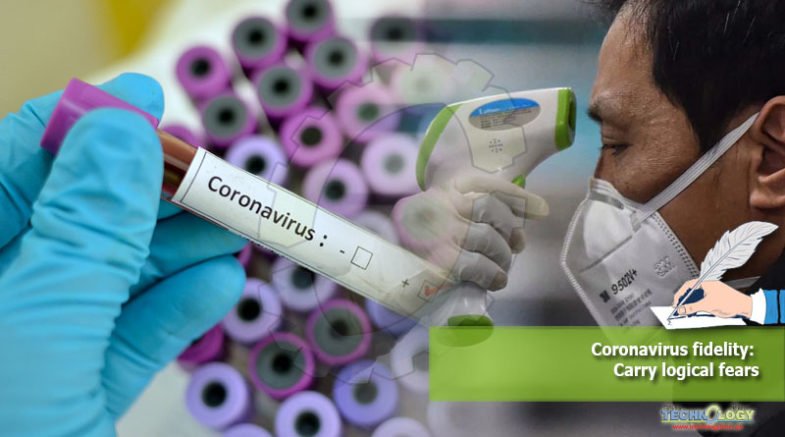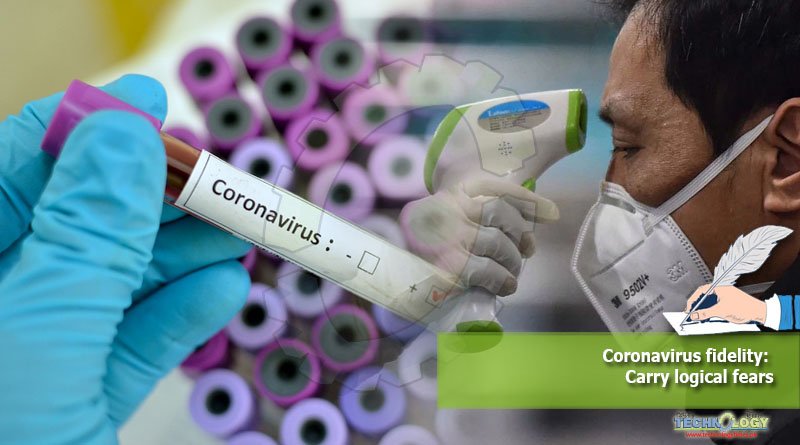To shake our beliefs on our capabilities to fix pandemics, we are having a crisis in making with the name 2019-nCoV or commonly called coronavirus. There is a flood of information about the outbreak from the ground zero “Wuhan” China which not only blinded the true perspective but also raises the level of fears among common people in neighboring countries including Pakistan about Coronavirus fidelity. The most alarming feature is its ability to spread person to person. A clear understanding of Wuhan Coronavirus , the SOPs of an affected state and precautionary measures are must have to keep fears at realistically and to avoid unworthy panic.

During the end of December 2019, soon after the reports of patients with acute respiratory syndrome in Chinese Wuhan city, Chinese authorities confirmed that they identified a novel version of coronavirus as a causative agent of these symptoms.
According to The New York Times (01 February 2020) death toll passed 300 and more than 14000 infections are confirmed predominantly in people from China or having a recent travel history to China. At present (13 February 2020) 60,408 coronavirus cases have been reported with 1,370 deaths. Keeping in view the time factor, the death toll is scary particularly when we all know China has the best potential, skills and human resources to deal with disasters. The truth, however, is that the fatality of 2019-nCoV is 2% which is significantly less than the SARS mortality rate of 9.6%. Chinese scientists shared the genetic sequence of the virus on 11 January 2020 which was appreciated by the international community. Earlier in case of SARS outbreak of 2003 the same information was not shared until the virus killed 774 people and infected more than 8,000 in China. Coronavirus was declared as a global health emergency by World Health Organization (WHO) but with confidence in the measures and strategies of the Chinese government to deal with the outbreak.
Two of the seven coronaviruses that infect humans, SARS and MERS, can cause severe pneumonia and even death. These viruses are common amongst animals worldwide, but only a handful of them are known to affect humans. Rarely, coronaviruses can evolve and spread from animals to humans. This is what happened with the coronaviruses known as the Middle East respiratory syndrome coronavirus (MERS-CoV) and the severe acute respiratory syndrome coronavirus (SARS-Cov), both of which are known to cause more severe symptoms. The rest lead to milder symptoms, like a common cold. Right now, it’s not clear where 2019-nCoV falls on that spectrum. Coronavirus belongs to the strain of viruses that can host humans but how? The nearest answer published in the Journal of Medical Virology, revealing snake as the likely intermediate host. It also suggests that a change in one of the viral proteins in 2019-nCoV allows the virus to recognize receptors on human cells as well. This ability is a critical step not only to target human cells but also confers switch potential of corona to hop humans. Several other candidate reptile species were reported and pangolin is the latest suspect involved in the trouble. Unfortunately no decisive scientific evidence is available to relate any animal specie with Wuhan outbreak till today.
It has been confirmed by CDC that the new coronavirus can spread person to person along with a report published in the New England Journal of Medicine. This reality is harder to deal as compared to the viruses which use animals as their intermediate hosts. According to the established standard principles of dealing with person to person viral infectious disease, the best strategies were adopted. Unfortunately, the most logical ways of dealing with infectious diseases are all against normal social behaviors and causing outrage in less aware minds. People to people contact in the affected region must be limited, it was done by restricting travel and closure of all public activity places including schools, universities and offices. The infected people should be kept and treated in isolation under strict code of precautionary measures. This creates dramatic images irrespective of the fact that this is the best way to contain Wuhan’s outbreak. The most efficient human response against 2019-nCoV can be made if the disease is cordoned off, allowing researchers and resources to develop antiviral solutions as soon as possible.
In case of viral infection, our natural defense mechanism tries to create antiviral proteins that kill the virus as well as the infected cells. The cured ones from this disease until today are not medically treated for a drug against 2019-nCoV. Their immune system created a successful response against the virus and treatment helps patients to survive the impact of the virus though. Isolation, on the other hand, reduce cases and decrease the cost to deal with the outbreak. Theoretically based on the date we have today, even without any antiviral drug against 2019-nCoV 98 out of 100 people will survive the infection provided they do not multiply the infections to others.
It takes two weeks on average for symptoms to start appearing. According to the WHO, signs of infection include fever, cough, shortness of breath and breathing difficulties. In more severe cases, it can lead to pneumonia, severe acute respiratory syndrome, kidney failure and even death. The incubation period of the coronavirus remains unknown. Some sources say it could be between 10 and 14 days. This means if a person receives infection few days ago , he will not show any symptoms today and could be a reason to spread the disease. Therefore if someone is coming from an infected area it is necessary to quarantine him for two weeks to make sure he is clear. To avoid 2019-nCoV the public should do what is necessary to avoid cold and flu. Frequent cleaning of hands with soap and water, covering mouth and nose while coughing and sneezing. Avoid contact with anyone with cold or flu-like symptoms or with symptoms of any respiratory disease.
Understanding the real concern behind any person to person viral infection is more important. We don’t have a cure that does not mean everybody will be dead with the disease. Sooner we will be able to find the appropriate antiviral therapy for 2019-nCoV as well using synthetic or biological means. All we need to do is to contain the virus so the number of patients does not increase to an exponential level where death tolls start the free fall of other civic arrangements. Closing borders, suspending flight operations, suspecting international arrivals for a disease is all that we should logically be doing in Pakistan. This will help healthy people to stay healthy and infected people to find a better chance of survival.
M. Zohaib Iqbal is Co-author of the this article
